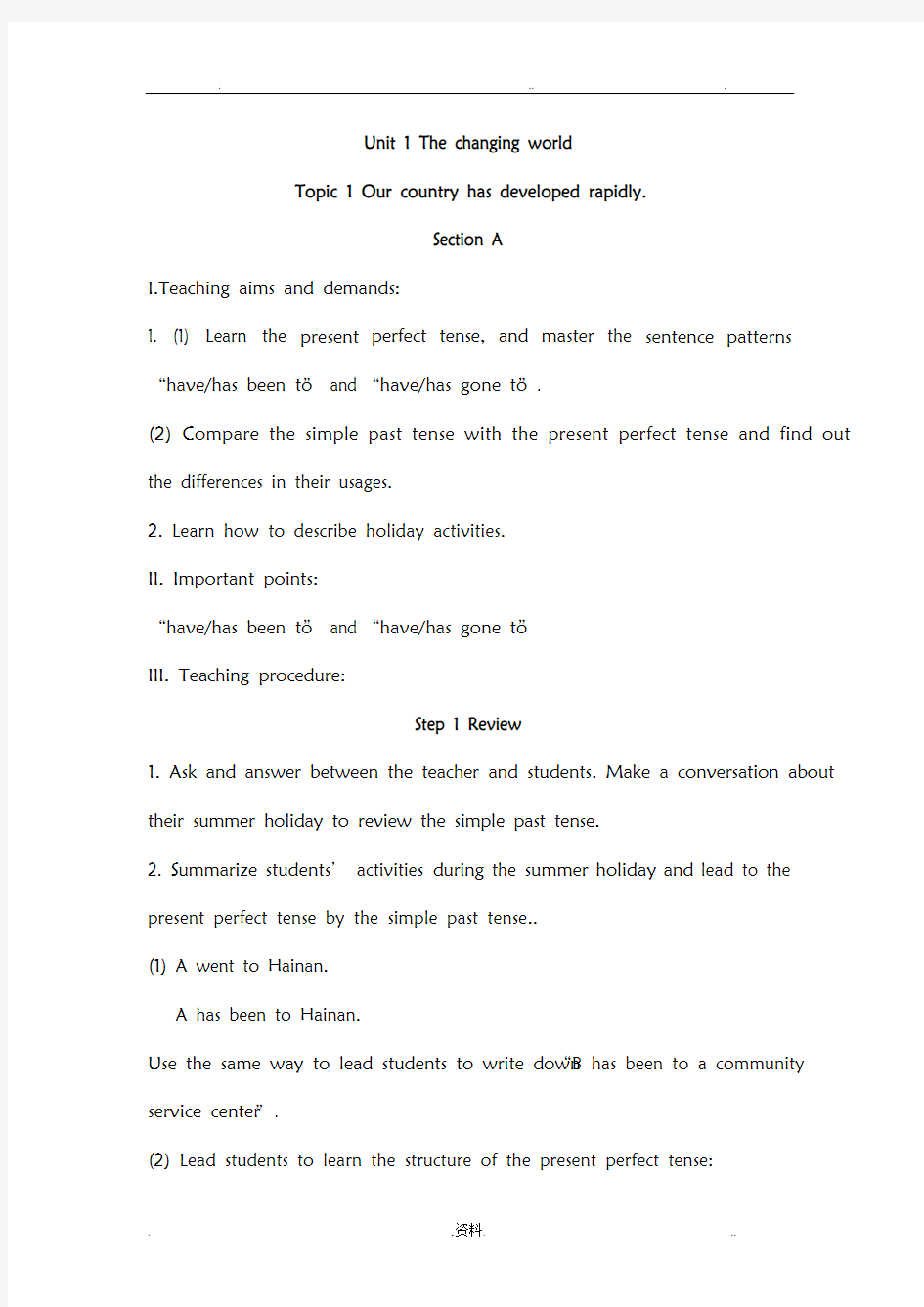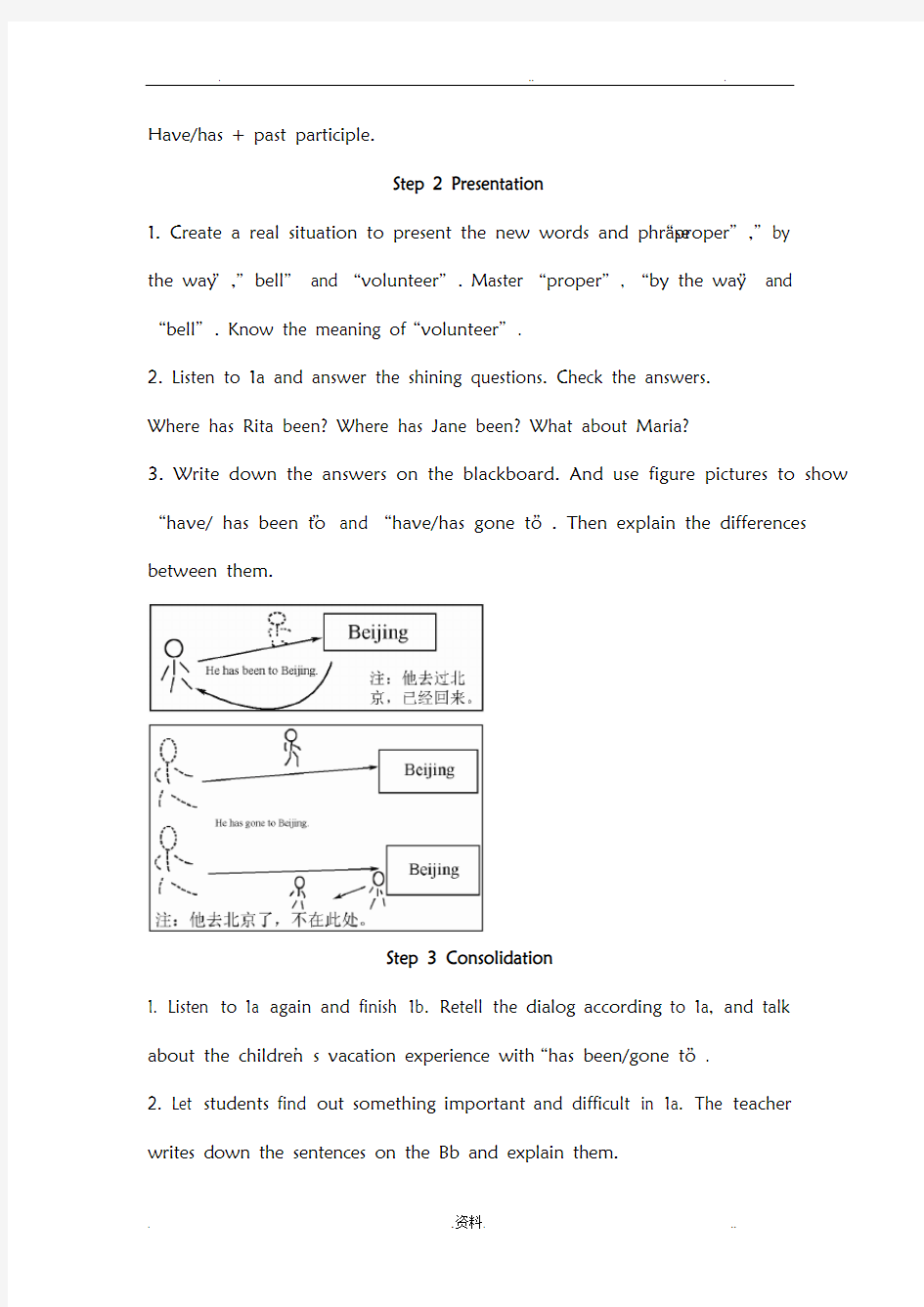

Unit 1 The changing world
Topic 1 Our country has developed rapidly.
Section A
I.Teaching aims and demands:
1. (1) Learn the present perfect tense, and master the sentence patterns “have/has been to” and “have/has gone to”.
(2) Compare the simple past tense with the present perfect tense and find out the differences in their usages.
2. Learn how to describe holiday activities.
II. Important points:
“have/has been to” and “have/has gone to”
III. Teaching procedure:
Step 1 Review
1. Ask and answer between the teacher and students. Make a conversation about their summer holiday to review the simple past tense.
2. Summarize students’activities during the summer holiday and lead to the present perfect tense by the simple past tense..
(1) A went to Hainan.
A has been to Hainan.
Use the same way to lead students to write down “B has been to a community service center”.
(2) Lead students to learn the structure of the present perfect tense:
Have/has + past participle.
Step 2 Presentation
1. Create a real situation to present the new words and phrase “proper”,”by the way”,”bell” and “volunteer”. Master “proper”, “by the way” and “bell”. Know the meaning of “volunteer”.
2. Listen to 1a and answer the shining questions. Check the answers.
Where has Rita been? Where has Jane been? What about Maria?
3. Write down the answers on the blackboard. And use figure pictures to show “have/ has been to” and “have/has gone to”. Then explain the differences between them.
Step 3 Consolidation
1. Listen to 1a again and finish 1b. Retell the dialog according to 1a, and talk about the children’s vacation experience with “has been/gone to”.
2. Let students find out something important and difficult in 1a. The teacher writes down the sentences on the Bb and explain them.
3. Read 1a in groups and choose several groups to act it out. Finish 1a.
4. Work in groups. Make up dialogs like 1a according to students’real situations and act them out I pairs. Finish 1c.
Step 4 Practice
1. Let students look at the picture in 2 and read the dialogs aloud. Fill I the blanks. Finish
2. Let students have a better understanding about the differences between “have/has been to” and “have/has gone to”.
2. Learn and master the new words “grandpa”, “chairwoman”and “grandson” by using word formation.
3. Let students find different sentence patterns of the perfect tense in this section and practice them.
Step 5 Project/work after class
1. Free work..
2. Do some exercise about “have/has been” and “have/has gone”. Handwriting:
Our country has developed rapidly.
Section A
by the way —Where have you been, Jane?
There goes the bell. —I have been to …
proper Maria isn’t at school. Where’s she?
chairwoman —She has gone to …
Section B
I.Teaching aims and demands:
1. Go on learning the usage of the present perfect tense.
2. Compare the teenagers’life in the past with that nowadays and lead students to cherish the happy life at present.
II. Important points:
1. Past Participle
2. The usage of the present perfect tense
III. Teaching procedure:
Step 1 Review
1. Check the work after class.
2. Ask and answer between the teacher and students. Review the present perfect tense.
Step 2 Presentation
1. Show some pictures of disabled children. Make a dialog with students to know whether they have helped disabled children and lead to 1a. Understand the new word “disabed” and master “ever”.
2. Listen to 1a and answer the shining questions:
(1)Has Maria ever helped disabled children?
(2)What did she do to help them?
Step 3 Consolidation
1. Let students read 1a and find out the important sentences and the sentences with the present perfect tense. The teacher writes them down on the Bb and explain them. Finish 1a.
2. Let students observe the past participle of verbs in the five sentences with the present perfect tense on the Bb. Learn the rules of the past participle of verbs. Fill in the blanks in 1b with different forms of the verbs. Master the new words “shut” and “rope”. Know the new word “online”. Check the answers.
3. Make a survey about students’summer holidays. Then make up dialog in pairs according to the table in 1b. Encourage students to take part in outdoor activities. Finish 1b.
Step 4 Practice
1. Show two pctures about the life of teenagers in the past and at present and then make a comparison. Lead to 2a. Learn and master the new words and phrase “describe”, “in detail”, “education”, “develop”and “development”. Understand the words “teenagers”, “childhood”,
“support” and “laborer”., Know about the new word “rapidly”.
2. Let students listen to 2a and answer the shining question:
How did most children spend their childhood in the past?
3. Read 2a after the tape. Let students mark the stresses and sense-groups. Then erase the marks. Read 2a aloud in imitation of the tape.
4. Read 2a again. Master the new word “granny” and know about the new word “luckily”. Finish 2a. Compare the different lifestyles in the past and at present of Chinese teenagers. Finish 2b.
5. Let students listen to 2c and fill in the blanks. Check the answers. Finish 2c.
Step 5 Project/work after class
1. Free work.
2. Do some exersice in TOPENGLISH.
Handwriting:
Section C
I.Teaching aims and demands:
1. Go on learning the present perfect tense.
2. Compare the past Beijing with the present Beijing and learn about the great changes in China.
3. Inspire students to cherish the happy life at present and to cultivate their patriotism.
II. Important points:
1. some new words and phrases
2. (1)My granny has lived in Beijing for more than forty years.
(2)Beijing has made rapid progress and it has already succeeded in hosting the 2008 Olympic Games.